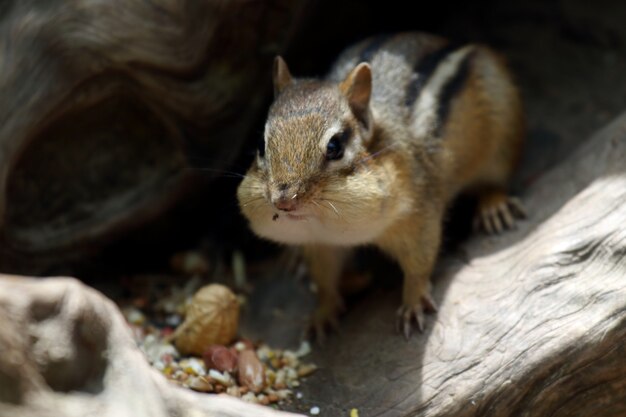Fascinating Facts about Chipmunks

Chipmunks are small, striped rodents native to North America.
They are known for their bushy tails and pouches in their cheeks.
Chipmunks belong to the squirrel family and are closely related to ground squirrels and marmots.
These adorable creatures are diurnal, meaning they are most active during the day.
Chipmunks are excellent climbers and can quickly scale trees and bushes.
They communicate with a variety of vocalizations, including high-pitched chip-chip sounds.
Chipmunks have powerful front teeth that continually grow throughout their lives.
These teeth help them gnaw through tough nuts, seeds, and even acorns.
Chipmunks are omnivores, meaning they eat both plant matter and small insects.
They are food hoarders and collect and store food in underground burrows.
Chipmunks have specialized cheek pouches that allow them to carry large amounts of food.
They usually live alone or in small family groups.
Chipmunks are known for being territorial and will defend their territory fiercely.
They have prominent eyes that provide excellent vision, allowing them to detect predators from a distance.
Chipmunks have a lifespan of about 2-3 years in the wild.
They hibernate during the winter months and survive on the food they have stored.
Chipmunks have a natural instinct for digging intricate tunnel systems and burrows.
They line their burrows with leaves and grass for insulation and comfort.
Fascinating Facts about Chipmunks part 2
Chipmunks are intelligent animals and can quickly learn to navigate mazes and puzzles.
They have a high metabolism and need to eat frequently to maintain their energy levels.
Chipmunks have a distinctive chirping alarm call to alert others of potential danger.
Their fur coloration varies, but most chipmunks have a combination of brown, black, and white stripes.
Chipmunks have excellent memory skills, allowing them to remember the location of their burrows and food caches.
They have soft and dexterous paws that enable them to manipulate small objects.
Chipmunks are known to hide food in multiple locations, making it harder for other animals to steal their stash.
They are selective eaters and will go for the most nutritious parts of their food first.
Chipmunks have a specialized gland near their genitals that produces a scent used for marking territory.
They are fast runners and can reach speeds of up to 20 miles per hour.
Chipmunks are proficient swimmers and can paddle across small bodies of water.
They are curious animals and may investigate any new objects or scents in their environment.
Chipmunks are known to be meticulous groomers, spending a considerable amount of time caring for their fur.
They have an excellent sense of balance, allowing them to navigate the treetops with ease.
Chipmunks often build their burrows near fallen logs or tree roots for added protection.
They are vulnerable to predators such as hawks, owls, snakes, and domestic cats.
Chipmunks are sociable animals and may engage in playful interactions with one another.
They have an average body length of about 5-6 inches, excluding their tail.
Chipmunks are agile jumpers and can leap several feet in the air when startled.
They are capable of differentiating between various types of nuts and seeds based on scent and taste.
Chipmunks have a keen sense of hearing and can detect the slightest rustle of leaves or movement nearby.
They are known for their adaptability and can thrive in various habitats, including forests, meadows, and suburban areas.
Chipmunks have intricate burrow systems with separate chambers for sleeping, nesting, and storing food.
They are susceptible to diseases such as Lyme disease and fleas, which can be transmitted by ticks.
Chipmunks are important seed dispersers, as they often forget where they buried their food caches, allowing for new plant growth.
They have been featured in popular culture, with fictional characters such as Chip and Dale from Disney.
Chipmunks are fascinating creatures that bring joy and entertainment to those lucky enough to observe them in their natural habitats.

